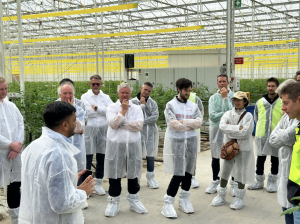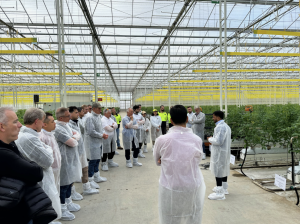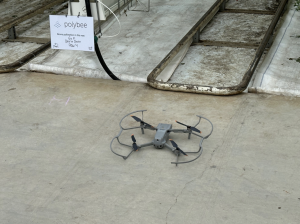On Tuesday the 30th of May, the Polybee company in conjunction with Flavorite and PCA, hosted a demonstration of their technology for 30 growers and trade members. Polybee have been working extensively in this sector to perfect a drone based pollination system to effectively replace a manual labour force.
The first thing that surprised all the delegates attending was that the drones used are basic ‘off the shelf’ units – the same type of device that you might purchase at JB Hifi or similar outlets. This has been a deliberate choice by Polybee to keep costs down. However it is the overlaying technology in the software that gives Polybee their finite control of the drones. Most of us had the idea that the drone would fly beside the plants but this is not the case.
The actual flight path of the drones takes them across the top of a double row and the downdraft from the rotors provides the agitation required. Even though the drones fly at an approximate height of 6 metres, the downdraft is substantial enough to cause some vigorous agitation of the strings and trusses. Polybee have also not just been satisfied with just ‘shaking’ the plants and have designed the drones downdraft to give the optimum airflow to provide the ideal agitation of the target tomato plants.
So does this mean that you have to appoint a staff member as ‘drone pilot’ who will guide the drone up and down each row? And the answer is effectively no. The drones themselves are guided by a number of QR (Quick Response) Codes that are placed throughout the greenhouse area to ensure an even and constant flight plan. So it was time to see all this theory in action and two of the drones were launched to commence their task. The simple description of the operation was ‘precision’.
The two drones were initially piloted to hover approximately 2 metres off the ground and then they climbed to their full working height and proceeded down the rows without the need for the ‘pilots’ to control the drones manually. The first obstacle the drones faced was a major crop support truss hanging vertically from the roof, but the drones simply hovered and very gently tracked sideways before continuing their journey back on the original trajectory.
The trial was held in a four hectare greenhouse with 100 metre rows, so the each drone took approximately 15 minutes to return to their starting point. Now this may seem to be a long period of time, but the team at Flavorite advised that to manually pollinate the whole crop area, they would need 14 staff members to be actively working on the crop at the same time, so the potential labour savings were obvious. Polybee have a general recommendation that four drones per hectare is the ideal number that would be required. Of course, the drone can only run for as long as the battery has power, so each drone would probably require a battery change over every two ‘runs’. Polybee recognise that this could be seen as an ongoing issue as a staff member would be required to manually change the batteries. However, they are now looking at a totally autonomous solution where the drone would fly to a station, and automatically enable a process to change batteries. As the saying goes – ‘Seeing is believing’, and all of us at the demonstration were certainly very impressed with the Polybee product. The company themselves acknowledge that they still have work to do, but the initial signs that this is a positive step forward for the industry are certainly there.


